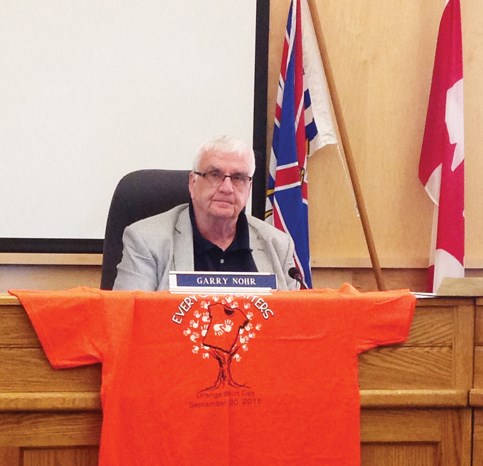Orange shirt day
Sunshine Coast Regional District (SCRD) chair Garry Nohr brought an unusual memento to the June 9 board meeting.
Nohr, recently back on the Sunshine Coast after attending the Federation of Canadian Municipalities (FCM) gathering in Winnipeg, draped a bright orange T-shirt across the board table at the start of the meeting and promised to explain the gesture during his director’s report.
Nohr told the board the shirts were being sold at the FCM convention by representatives from the Cariboo Regional District. He explained that regional district has adopted the orange shirt as a symbol of reconciliation, after hearing a story from a residential school survivor who arrived on the first day of school proudly wearing her favourite orange shirt, only to have it taken away and replaced with a uniform.
“I bought this one to put here at the RD to indicate how we’re working together with First Nations to try to correct some of the past wrongs,” he said. “There was a motion put forward at FCM to make a national [orange shirt] day, it would be on Sept. 30. They picked that day because it’s the end of the first month of school.”
Nohr also told the board that based on what he heard in Winnipeg, the Sunshine Coast is “light years ahead” when it comes to relations with First Nations and reconciliation.
Second hearing on AG zoning
The SCRD has set a public hearing date for the revised Agriculture (AG) zoning bylaw. AG zoning, if adopted, will replace the current Rural Use 3 (RU3) zoning to “broaden agricultural and farm opportunities” and to bring zoning rules for land within the Agricultural Land Reserve (ALR) in line with the latest provincial regulations.
Directors voted to amend the bylaw after the first public hearing on April 12, where several people raised concerns around setbacks for some farm-related activities, and the removal of kennels as an allowed use in parts of Areas E and F (they are permitted under RU3 zoning).
The amended AG zoning bylaw puts kennels back in as an allowed use, and reduces the required setbacks for animal slaughter and processing, agricultural waste storage, and areas used for preparing and storing a mushroom-growing medium.
The public hearing is June 29, 7 p.m. in the SCRD boardroom on Field Road.
Rec facility recognition
SCRD directors say they’re interested in finding a way to recognize grassroots groups that helped push for, and then built wide public support for, the construction of the arena and community centre in Gibsons, and the Sechelt Aquatic Centre.
At their June 9 community services committee meeting, directors debated a letter from former Gibsons and Area Community Centre Society (GACCS) member Celia Fisher, who wanted to know why the plaque acknowledging various contributions to the centre made no mention of GACCS, or the Mt. Elphinstone Recreation Centre Society that came before it.
Fisher’s letter says “these volunteers did yeoman work in developing plans, budgets, and a plan of action to ensure a successful referendum,” and suggests a second plaque be commissioned to recognize that work.
Elphinstone Director Lorne Lewis said it’s a valid point, and “there should be some acknowledgement to their efforts in the GACC building.”
Cliff Gilker
The SCRD will spend about $6,000 to replace a bridge over Clack Creek in Cliff Gilker Park.
The 18-metre (60 ft.) aluminum bridge was struck by a falling tree last December, forcing the closure of part of the park’s Red Trail. In February, crews removed the damaged bridge by helicopter and salvaged what they could. That cost $7,450, according to a staff report.
The seven metres of bridge that can be reused will replace a bridge on the Circle Trail in Area B.
The new bridge in Cliff Gilker will be a “single stringer” wooden bridge, instead of aluminum. SCRD staff say it’s less expensive, and could better absorb the impact of any future blow-downs.



